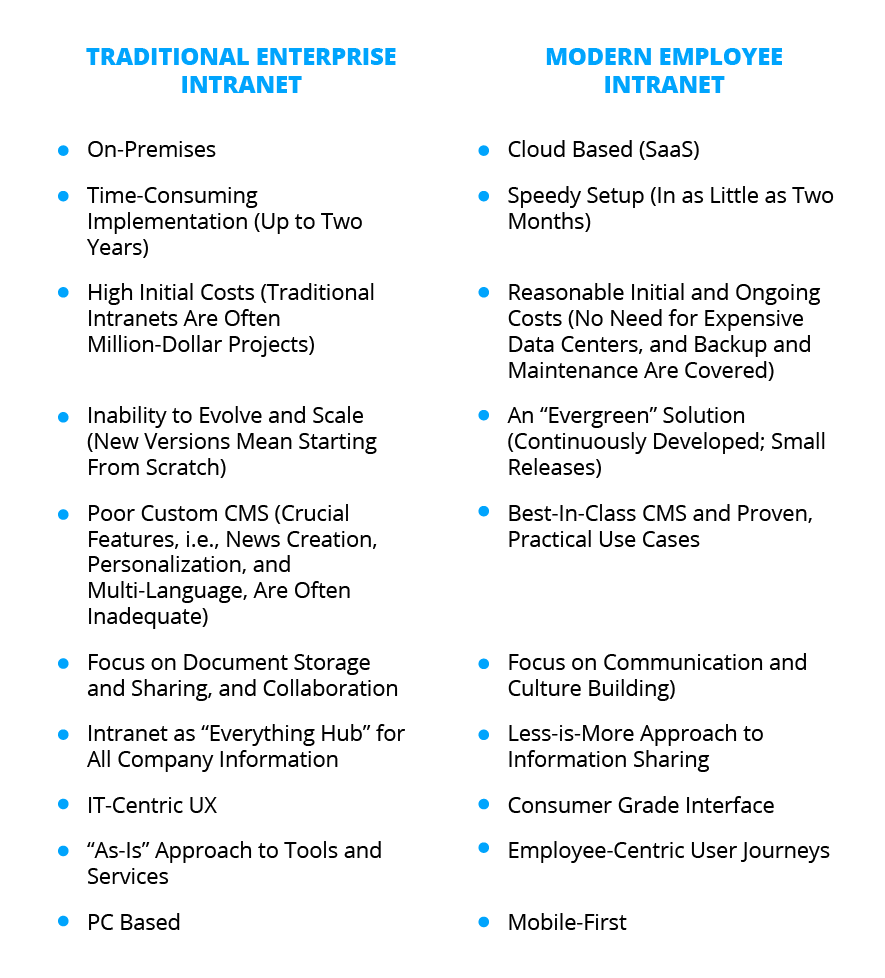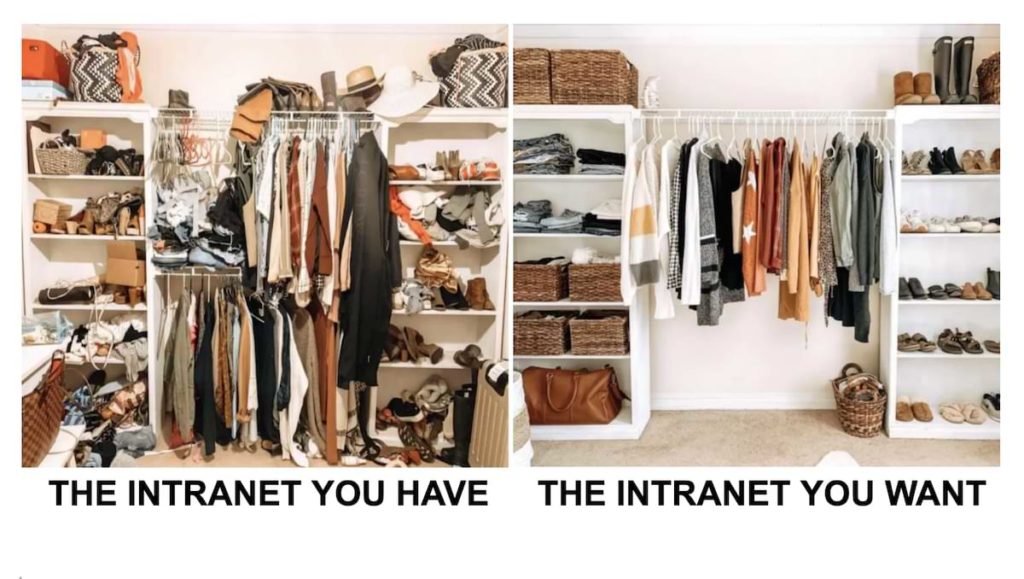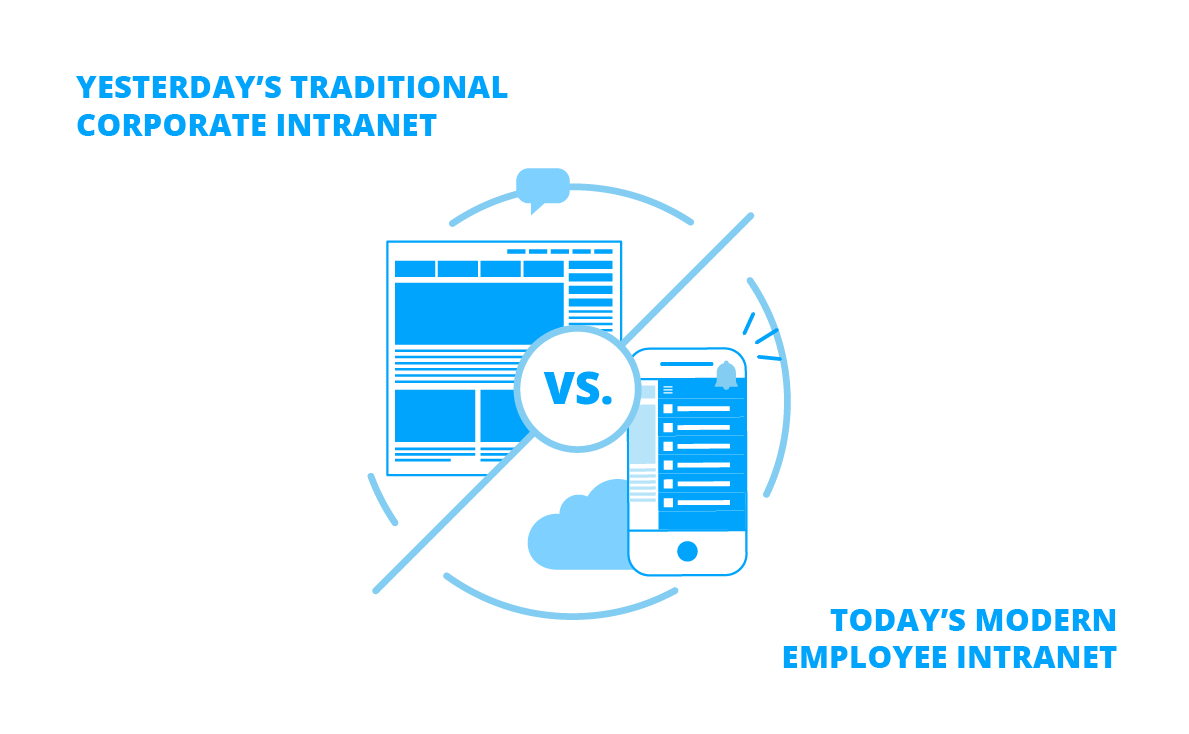It’s probably no coincidence that while a reported 87% of today’s workforce still typically receives company information via an employee intranet (in addition to email or in-person), it’s that exact same number who say that they’re unengaged with their jobs.
According to a 2018 Gallup poll, “a staggering 87% of employees worldwide are not engaged.” Could it be that these are the same people who continue to receive company information in unappealing, old-fashioned, and ultimately ineffective ways?
The main problem is that intranets — at least until fairly recently — were never meant to handle what in our mobile age has become the increasingly crucial task of easily and effectively sharing relevant information with all of an organization's employees.
This problem has only gotten worse as workforces become more remote and decentralized.

Successful Engagement Requires Strong Connections 🔗
Today’s enterprises need to completely rethink their approach to internal communication by looking to modern employee intranet platforms purpose-built for today’s mobile-first workforce. These platforms unlock the potential of the content stored on your traditional intranet (assuming you have one) and distributing it with ease and relevance.
Such solutions should take the following realities into account:
1. Today’s Work Is Mobile 📱
By now this might seem like a no-brainer, but it bears repeating. The way people work has been evolving in fundamental ways since the late 2000s. Spurred by the pandemic, 25% of all professional jobs in North America are expected to be remote by the end of 2022. And if employees travel to a traditional workplace at all, they're now taking their work home with them, too. Some on laptops and tablets, and even more on their smartphones.
These employees increasingly manage their tasks remotely with collaboration software ranging from Workplace by Facebook, to Slack, to Microsoft Teams. And that’s assuming they’re traditional employees to begin with. A significant segment of the workforce is now made up of non-employee contractors, or “gig workers.”
Taking into account the sizable percentage of employees who never step foot into a corporate office, the effectiveness of a traditional intranet diminishes even further.
2. Engaging Information Is Accessible Information 🤗
For an intranet to be useful, it must be accessible.
In the past, intranet access necessitated being physically on-premises at an office. But when your people can work from anywhere, and some of them aren’t even “official” employees, how can you expect them to access a company’s intranet content, which often sits behind a firewall?
Good luck if you expect them to log in with a company email. As many as half of a company’s employees don’t have a company email address. This makes it impossible to reach your entire workforce.
With a modern intranet, content can be either public or private. Staffbase supports multiple access methods — from printed access codes to single sign-on (SSO) solutions that reduce password fatigue while keeping passwords confidential.

3. Responsive Intranets Aren’t Truly Mobile ✈️ 🚄 🚗
Many intranets today have tried to adapt to the mobile reality by creating responsive websites. But a responsive intranet is not a mobile intranet.
"Responsive" means an intranet optimized to run on different screen sizes and to change its layout to fit different formats. But that doesn’t mean it’s a truly mobile experience, and there are consequences.
Most responsive channels of existing intranets have disappointing usage rates of less than 5% of overall traffic. Compare that to the more than 70% of mobile traffic that many mobile intranets are reported to achieve.
A true mobile experience is touch-based and takes full advantage of everything a mobile device has to offer. That means things like push notifications and touch and tap navigation. These are consumer-grade features that a responsive intranet experience simply cannot match.

4. Traditional Intranets Lack Analytics ⏱️
A modern-day employee intranet platform must constantly improve. For that to happen, it needs to enable robust measurement and monitoring of employee activity.
With a traditional intranet, organizations might be able to see how many views a document has received. But they can’t tell who’s read what. Old-fashioned intranets simply can't provide that level of specificity. They can't analyze trends of engagement on different days or at different times, or across different topics, mediums, locations, or job roles.
You can’t improve what you can’t measure — and traditional intranets don’t let organizations calculate how they’re performing for their employees. Engagement is an ongoing process. It never ends and it’s always evolving.
For a communication and engagement platform to grow with your organizational needs and employee expectations, it must measure everything it can and learn from the lessons it reveals.
5. Employees Demand Clarity and Trust in Personalized, Up-to-Date Information� ℹ️
Every single bit of today’s employee content needs personalization and timely delivery. And the same goes for its distribution. Managing content for maximum relevance means synchronizing its distribution though HR and content management systems.
In the SaaS world — especially with intranets built around Office 365 — companies risk offering an experience that’s as fragmented as the increasing number of applications their employees are using to do their jobs. This can be confusing, because just as company communication must be individually relevant in order for maximum engagement, its distribution should be personalized and focused.
A modern employee intranet consolidates access across multiple applications. Employees have a clear entryway into their digital workplace via a single application that contains only the content and tools that are individually relevant to them.
This is a far cry from the “everything hubs” that intranets looked like in days gone by. And bear in mind that the outward-facing half of a modern employee intranet isn't the place for storing all of a company’s documents. That's what your traditional document management and storage systems are for.

But a modern employee intranet will allow companies to distribute clear, trusted, and up-to-date information directly to their people while still allowing them to securely store sensitive or confidential content. Think of these two approaches as being two sides of the same coin.
Modern organizations would be wise to adopt this less-is-more approach, putting a greater focus on employee engagement and culture with a mobile intranet based around internal communication.
6. The Cloud Has Revolutionized the Digital Workplace ☁️
As workers have been going mobile, a whole new world of Cloud-based Software as a Service (SaaS) applications have become available to the enterprise. This hugely revolutionary development means that individual employees can subscribe to the software they need and organizations no longer require physical data centers to build and house it.
But there's a big catch.
With each new application comes a unique interface and the often-confusing reality that employees have different portals for different apps: one for the intranet, one for HR services, one for a calendar, etc.
Because these tools lack consolidation, employees have to constantly check all of these systems, which generally require separate logins. In addition, they likely also need secure remote access to these various systems, creating a conflict between security and reach.
In short, this isn’t how a single-destination intranet should work, stretched well beyond its capabilities in order to serve an ever-expanding SaaS world.




